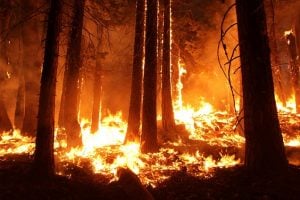Will PG&E's Liability Shield Work Better Than Its Equipment?
All of this is going to end up screwing California taxpayers.

U.S. Forest Service photo by Mike McMillan.
It’s a little early to call Captain Hindsight and start playing the blame game for the deadly California wildfires. At least 56 people are dead, more are missing, and… things are still literally on fire.
But, soon, we’re going to assign responsibility for this disaster. A hotter, dryer climate is a culprit. Trump’s cuts to fire protections services is a contributing factor. But, from a proximate cause perspective, it sure looks like the Pacific Gas & Electric company’s faulty equipment is going to be playing the roll of Long Island Railroad to the California homeowner’s version of Palsgraf.

Early Adopters Of Legal AI Gaining Competitive Edge In Marketplace
PG&E has already been sued by residents of Paradise, CA — a town that took the brunt of what has been dubbed the “Camp Fire.” From Curbed:
The suit, “Quammen Et Al vs. PGE,” lists a total of 25 plaintiffs, all described as “an owner and/or occupants of real property damaged by the Camp Fire.”
Attorneys with Millbrae-based Corey, Luzaich, de Ghetaldi, and Riddle excoriate PG&E’s safety record, claiming that “the Camp Fire started when a high-voltage transmission line failed, igniting vegetation.” The lawsuit hopes to place potentially expensive legal liability for the deadliest and most destructive California fire on the utility company.
Power companies have extensive liability shields to protect them from exactly this kind of situation. PG&E has been held liable in the past for fires. But the destruction from this fire is off the charts.
That’s not my opinion, that is PG&E’s opinion, as related in its latest SEC filing. From MarketWatch:
Sponsored

Early Adopters Of Legal AI Gaining Competitive Edge In Marketplace

The Business Case For AI At Your Law Firm


Navigating Financial Success by Avoiding Common Pitfalls and Maximizing Firm Performance

Is The Future Of Law Distributed? Lessons From The Tech Adoption Curve
In the filing on Tuesday, PG&E said the outage happened in the area of Butte County near the city of Paradise where the fire is understood to have started. Paradise was all but completely wiped out in the blaze.
PG&E warned that while it had renewed its liability insurance coverage for wildfire events in its most recent quarter to an aggregate amount of about $1.4 billion, it could be facing a far larger bill that would have serious implications for its finances.
The company’s stock is tanking. PG&E is drawing down debt.
“This is a surprising move and it is potentially consistent with a bankruptcy filing,” said Michael Wara, a professor at Stanford Law School, “but there are other potential explanations that are also possible, especially under the circumstances in which PG&E finds itself.”
Companies preparing for bankruptcy often draw down their debt to avoid more onerous financing terms through the bankruptcy process, Wara said. But PG&E could also be putting cash in the bank to insulate itself from other financial situations.
All of that means that California taxpayers will be on the hook for the billions of dollars PG&E’s insurance won’t cover. It means PG&E could ask for a bailout from the state.
And it means that while everybody figures out how to pay for the recovery, nobody is going to be figuring out how to pay for the new equipment and infrastructure necessary to prevent old power lines from starting forest fires.
Sponsored

Is The Future Of Law Distributed? Lessons From The Tech Adoption Curve

Legal AI: 3 Steps Law Firms Should Take Now
These are the kind of things that happen to a nation in decline.
PG&E sued over deadly Camp Fire [Curbed]







